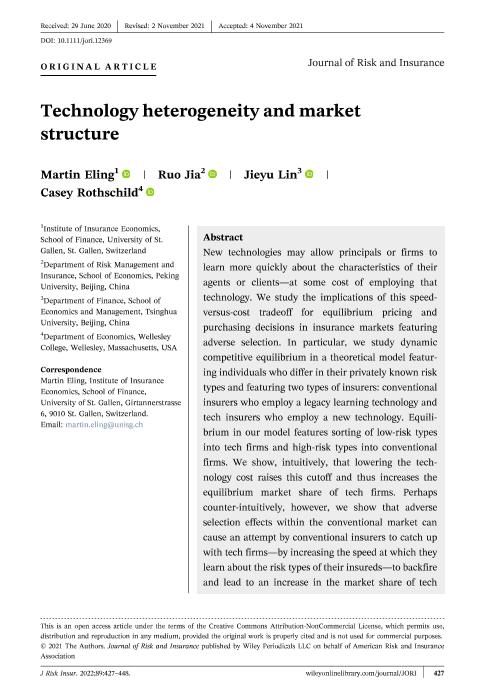Technology heterogeneity and market structure

Contenido multimedia no disponible por derechos de autor o por acceso restringido. Contacte con la institución para más información.
| Tag | 1 | 2 | Valor |
|---|---|---|---|
| LDR | 00000cab a2200000 4500 | ||
| 001 | MAP20220014090 | ||
| 003 | MAP | ||
| 005 | 20220510142358.0 | ||
| 008 | 220510e20220509esp|||p |0|||b|spa d | ||
| 040 | $aMAP$bspa$dMAP | ||
| 084 | $a7 | ||
| 245 | 0 | 0 | $aTechnology heterogeneity and market structure$cMartin Eling...[et.al.] |
| 520 | $aNew technologies may allow principals or firms to learn more quickly about the characteristics of their agents or clientsat some cost of employing that technology. We study the implications of this speed-versus-cost tradeoff for equilibrium pricing and purchasing decisions in insurance markets featuring adverse selection. In particular, we study dynamic competitive equilibrium in a theoretical model featuring individuals who differ in their privately known risk types and featuring two types of insurers: conventional insurers who employ a legacy learning technology and tech insurers who employ a new technology. Equilibrium in our model features sorting of low-risk types into tech firms and high-risk types into conventional firms. We show, intuitively, that lowering the technology cost raises this cutoff and thus increases the equilibrium market share of tech firms. Perhaps counter-intuitively, however, we show that adverse selection effects within the conventional market can cause an attempt by conventional insurers to catch up with tech firmsby increasing the speed at which they learn about the risk types of their insuredsto backfire and lead to an increase in the market share of tech firms. Our results are readily adapted to bank lending and labor market settings. | ||
| 650 | 4 | $0MAPA20080586546$aNuevas tecnologías | |
| 650 | 4 | $0MAPA20080586294$aMercado de seguros | |
| 773 | 0 | $wMAP20077000727$g09/05/2022 Volumen 89 Número 2 - mayo 2022 , p. 427-448$x0022-4367$tThe Journal of risk and insurance$dNueva York : The American Risk and Insurance Association, 1964- |

